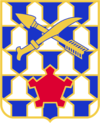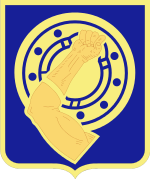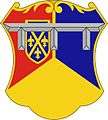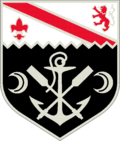1st Brigade Combat Team, 1st Infantry Division (United States)
| 1st Brigade Combat Team, 1st Infantry Division | |
|---|---|
|
1st Brigade Combat Team, 1st Infantry Division's insignia | |
| Active |
1917-1939 1942-1943 1958-1962 |
| Branch | Regular Army |
| Type | Brigade combat team |
| Role | Infantry |
| Garrison/HQ | Fort Riley |
| Nickname(s) | "Devil Brigade"[1] |
| Motto(s) | Duty First |
| Mascot(s) | Devil |
| Engagements | |
| Commanders | |
| Current commander | Colonel Chuck Armstrong |
The 1st Brigade Combat Team, 1st Infantry Division ("Devil Brigade")[1] is the oldest permanent brigade in the United States Army and has some of the oldest units in the United States Army. HHC, 1st Brigade served in World War I, Vietnam, Desert Shield and Desert Storm. Its most notable campaigns include the Aisne-Marne, Meuse-Argonne, Picardy, Tet Counteroffensive and the Liberation and Defense of Kuwait. Since Desert Storm, the "Devil" Brigade deployed to Bosnia, Kuwait, and went to Korea to participate in a 2nd Infantry Division exercise.
History
World War I
Headquarters and Headquarters Company was constituted 24 May 1917 into the Regular Army as Headquarters, 1st Brigade, an element of the 1st Expeditionary Division (later redesignated as the 1st Infantry Division).[2]




Commanders 1st Infantry Brigade
- 1917
- 9 June Colonel Omar Bundy
- 28 June Brigader General Omar Bundy
- 25 August Colonel Ulysses G. McAlexander (ad interim)
- 30 August Brigader General Omar Bundy
- 8 September Brigader General George B. Duncan
- 1918
- 16 January Colonel John L. Hines (ad interim)
- 21 January Brigader General George B. Duncan
- 5 May Brigader General John L. Hines
- 27 August Brigader General Frank Parker
- 18 October Colonel Hjalmar Erickson (ad interim)
- 21 November Brigader General Frank Parker
- 20 December Colonel Charles A. Hunt (ad interim)
- 1919
- 5 January Brigader General Frank Parker
- 12 January Colonel Charles A. Hunt (ad interim)
- 17 January Brigader General Frank Parker
- 27 January Colonel William F. Harrell (ad interim)
- 29 January Brigader General Frank Parker
- 16 February Colonel Charles A. Hunt (ad interim)
- 29 March Brigader General Frank Parker
- 1 April Colonel Charles A. Hunt (ad interim)
- 11 April Brigader General Frank Parker
- 25 April Colonel Charles A. Hunt (ad interim)
- 7 May Lieuenant Colonel Edward R. Coppock (ad interim)
- 9 May Lieuenant Colonel William F. Hoey (ad interim)
- 13 May Brigader General Frank Parker
- 8 July Colonel William W. McCammon (ad Interim)
- 18 July Brigader General Frank Parker
- 21 July Colonel William W. McCammon (ad interim)
- 24 July to 3 September Brigader General Frank Parker
World War II
The 1st Infantry Brigade was stationed at Fort Wadsworth on Staten Island, New York as part of the 1st Infantry Division until 11 October 1939, when it was inactivated when the division was converted to a Triangular Table of Organization and Equipment.
After the army's conversion to the triangular division, only two separate brigades were formed during World War II, the 1st Airborne Infantry Brigade and the 2nd Airborne Infantry Brigade.[3]:29 The 1st Airborne Infantry Brigade was formed at Fort Benning, Georgia, on 20 July 1942 originally as the 1st Parachute Infantry Brigade.[4] The unit changed its name from "parachute" to "airborne" after having the 88th Glider Infantry Regiment assigned to it. After having its units removed and sent to different theatres the brigade was disbanded seven months later.[5]
Cold War
Under the United States Army's pentomic reorganisation, the 1st Infantry Brigade was recreated as an independent unit at Ft. Benning from 1958-62. When the First Brigade rejoined the 1st Infantry Division the brigade was renamed the 197th Infantry Brigade.[3]:231
Operation Iraqi Freedom
On 23 July 2003, US Army Forces Command alerted the 1st Brigade Combat Team (BCT) for deployment to the Iraq Theater of Operations in support of Operation Iraqi Freedom. The brigade deployed its main body starting on 2 September, closing in Kuwait by 11 September. Initially attached to the 82nd Airborne Division, the brigade occupied Area of Operations Topeka and conducted Transition of Authority with the 3rd Squadron, 3d Armored Cavalry Regiment, on 26 September. On 20 March 2004, CJTF-7 attached 1st Brigade to the 1st Marine Division to continue its offensive operations in AO Topeka.
In the following twelve months, the brigade's offensive operations killed 541 insurgents, wounded 101 more, and detained over 2,081 enemy fighters, including the capture of 18 high-value targets and 20 foreign fighters. The brigade responded to hundreds of small arms and RPG engagements, as well as over 550 IED (improvised explosive device) attacks. In order to disrupt the enemy's ability to conduct operations, the brigade captured 41 heavy machine guns, 175 RPG launchers, 3,134 mortar and artillery rounds, 1,781 rockets, and 17 surface-to-air missiles. In addition to combat operations, the brigade formed and trained the 60th Iraqi National Guard Brigade, including the 500th, 501st, and 502nd ING Battalions. 1st Brigade also sponsored over $23.8 million in civil projects in the Al Anbar province. The BCT returned to Fort Riley in September 2004.
In January 2005 the 1st Brigade was again called upon to prepare for deployment for OIF. The brigade spent the majority of 2005 refitting and training for deployment in fall 2005. This training culminated with the brigade's deployment to the Joint Readiness Training Center in August and September 2005.
In January 2006 the 1st Brigade received a mission change and began restructuring in order to better train military transition teams for their deployment.[6][7][8][9]
Several security force companies, or SECFOR companies, began preparing to deploy to Iraq in the fall of 2006.
On 23 September 2009, the brigade officially moved the military transition team mission to Fort Polk, LA and stood up as a deployable heavy brigade combat team.[10] The last of the MiTTs trained by the brigade completed their mission in October 2010. [11]
Current Organization
1st Armored Brigade Combat Team (Devil Brigade)








References
- 1 2 "Special Unit Designations". United States Army Center of Military History. 21 April 2010. Archived from the original on 9 June 2010. Retrieved 23 June 2010.
- ↑ http://www.history.army.mil//html/books/077/77-3/cmhPub_077-3.pdf Joining the Great War==
- 1 2 McGrath, John J. (2004). The Brigade: A History, Its Organization and Employment in the US Army. Combat Studies Institute Press.
- ↑ Stanton, Shelby L. (1984). Order of Battle: U. S. Army, World War II. Presidio Press. p. 191.
- ↑ Wilson, John B (1999). Maneuver and Firepower: The Evolution of Divisions and Separate Brigades. Government Printing Office. p. 190.
- ↑ https://www.army.mil/article/1896/mitt_training_at_fort_riley
- ↑ https://www.army.mil/article/501/army_secretary_views_mitt_training_at_fort_riley
- ↑ https://usacac.army.mil/CAC2/MilitaryReview/Archives/English/MilitaryReview_20091231_art008.pdf MiTT Adivsor: A year with the best division in the Iraqi Army
- ↑ http://www.almc.army.mil/alog/issues/MarApr09/log_transteam.html Logistics Training Team
- ↑ https://www.army.mil/article/25521/fort_riley_trains_last_transition_team_before_mission_moves_to_fort_polk
- ↑ http://www.riley.army.mil/News/Article-Display/Article/471105/fort-rileys-last-transition-team-class-returns-home/
- ↑ "1st Armored Brigade Combat Team". www.riley.army.mil. Retrieved 2018-03-19.
- 1st Brigade History, U.S Army (accessed 17 November 2005)